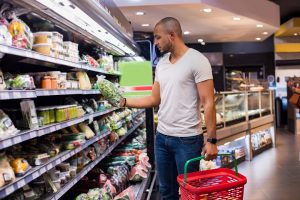
Wonder how your groceries get to the shelves? A truck is often involved.
Have you ever wondered how your groceries get to the store? Food uses multiple modes of transportation to get to the grocery store, though there are definitely more common methods. Domestically, trucks are the primary transporters of groceries. They carry nearly 70% of the food consumed in the U.S., with the following most common method being railways. A desire to provide fresh and local food combined with a need for consistent varieties and a wide selection makes for the complicated process of grocery logistics. Let’s learn more about how groceries get to the store.
How Does the Grocery Supply Chain Work?
The grocery supply chain works from the bottom up, starting at the food source and ending once you leave the grocery store with a cart full of products. The grocery supply chain includes:
- Raw goods/agriculture
- Warehouse
- Distributor
- Retailer
- Consumer
Why Grocery Stores Use Distributors
Grocery stores use distributors for consistency and ease. If someone buys all your favorite granola bars from your local store, a quick scan ensures they are refilled on the next shipment and that the store doesn’t need to bring in fifteen cases to make it happen. These food distributors essentially keep a large inventory of food items ready and available for grocery store purchases. The grocery store distributors are typically placed in a central location to ship the products to the stores when they order them.
How Do Groceries Get to the Store?
The produce, meat, and seafood sections of the grocery store rely on a variety of distributors to stock the shelves. Distributors have warehouses full of inventory being held at specific temperatures, ready to be sent out to retailers with a day’s notice at the exact level of ripeness desired by the customer. Produce changes seasonally, but Mexico, California, and Florida traditionally provide the majority of native fruits and vegetables in North America. Many distributors will attend regional produce auctions to purchase en masse.
Butcher shops and seafood department supply lines are similar to other areas of the grocery store. Regional distributors frequently deliver commodity meats, including brands of big companies, while local farmers and ranchers offer branded products with more traceability and transparency.
Why is the Grocery Supply Chain Important?
After learning the process of how your groceries get to the store, you can understand why many stores have been having supply chain issues. If even one of those steps is delayed or shut down, the entire chain stops working. During the pandemic, food processors and manufacturers were forced to shut down their services or become delayed. The supply chain is necessary for consumers to be able to get the food they typically purchase.
For All Your Trucking Needs
Follow us here at Evan Transportation to get more updates on driving tips and the trucking industry. Evan Transportation provides trucking and transportation services for clients throughout the Mid-Atlantic region. All of our drivers and staff are offered competitive salaries and benefits and are guaranteed to be home every day. Interested in finding out more? Visit us online or give us a call at 443-673-3365. For even more information, visit us on Facebook, Twitter, Pinterest, and LinkedIn.
